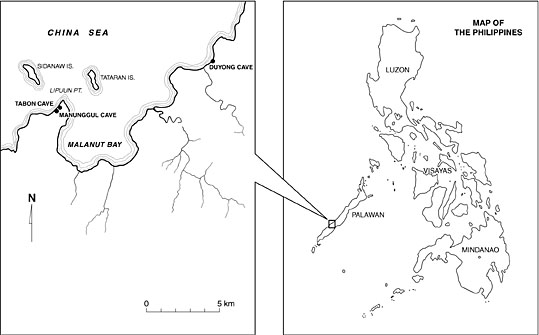

 | Page 1256 |  |
bones on the surface when first seen. Ranging in date from 710 to 890 b.c., this site also contained jade, shell, and stone beads and jade, agate, and shell bracelets.

Tabon Caves
The most important find in Chamber A was a burial jar, which on its cover bears the motif of a ship-of-the-dead. Now considered a national cultural treasure of the Philippines, the upper portion of the jar has curvilinear incised scroll designs, and it was painted with hematite after firing. There are two human figures on the jar; one is shown paddling the boat and the other has its hands folded over its chest. The figures seem to have bands tied around the crowns of their heads and under their jaws. This band pattern and the manner in which the arms are folded across the chest are still widely practiced in the archipelago as part of funeral rites.
Chamber B has a radiocarbon date of 190 b.c. This part of the cave contains iron in addition to the associated archaeological materials recovered from Chamber A. Shell spoons made from the chambered nautilus were found in Chamber B, and the recovery of two round pebbles with a brilliant sheen on both sides suggests the use of these materials for polishing pottery.
Duyong Cave is located in the Iwaig area about eleven kilometers north of Tabon Cave and is situated near the coast. Excavations here revealed the presence of a flexed male burial with associated cultural materials including a stone adze, four polished shell adzes made from the giant clam Tridacna gigas, two ear disks, and a pendant made from the perforated bases of Conus shells. Six lime containers for betel-nut chewing, made from Arca shells, were also recovered. The radiocarbon date for Duyong Cave is 3100 b.c. It is significant that polished shell adzes made from the giant clam Tridacna gigas are also found in Micronesia, the Miyako Islands, and the Yaeyama Islands in the southern Ryuku chain as well as on numerous Pacific islands (Asato 1990).
In addition, Duyong Cave contained jade ornaments and a pottery mold for the manufacture of bronze adzes. The jade ornaments include types of ear pendants described as “lingling-o,” which are related to ear pendants made of metal and still used by the Ifugao tribe in northern Luzon in the Philippines. Other artifacts made of jade included bracelets, a few beads, and studlike objects. The most unique
 |  |